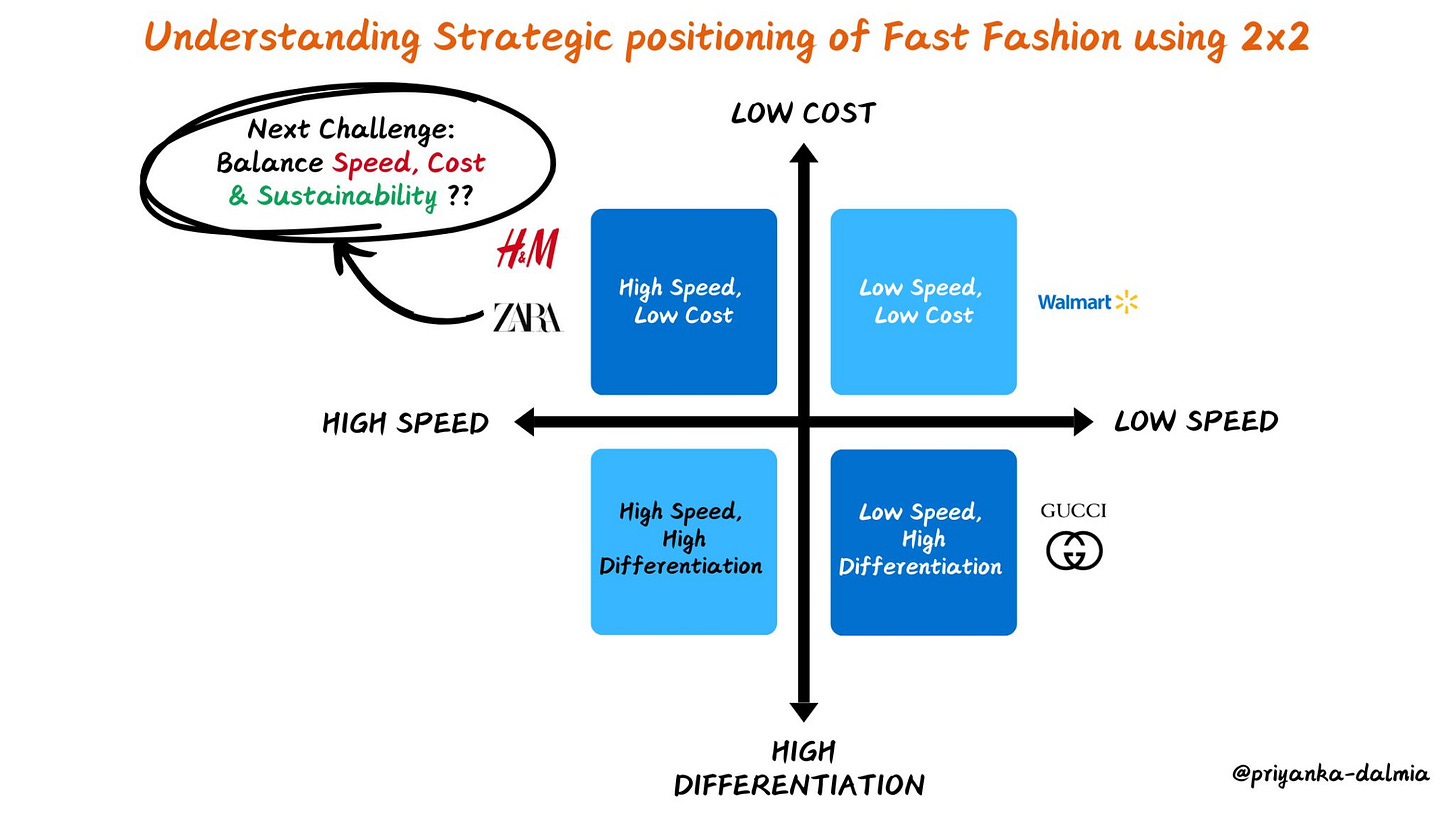Every time I walk into Zara I wonder how they have new designs on the display.
Let's Decode their Business Strategy in [ 2 X 2 ]
Zara positions itself as High Speed & Low Cost ( Mass Premium Fast Fashion )
𝗛𝗶𝗴𝗵 𝗦𝗽𝗲𝗲𝗱, 𝗟𝗼𝘄 𝗖𝗼𝘀𝘁: Zara & H&M dominate.
𝗟𝗼𝘄 𝗦𝗽𝗲𝗲𝗱, 𝗛𝗶𝗴𝗵 𝗗𝗶𝗳𝗳𝗲𝗿𝗲𝗻𝘁𝗶𝗮𝘁𝗶𝗼𝗻: Luxury brands like Gucci focus on exclusivity.
𝗟𝗼𝘄 𝗦𝗽𝗲𝗲𝗱, 𝗟𝗼𝘄 𝗖𝗼𝘀𝘁: Discount retailers like Walmart prioritize basics.
𝗛𝗶𝗴𝗵 𝗦𝗽𝗲𝗲𝗱, 𝗛𝗶𝗴𝗵 𝗗𝗶𝗳𝗳𝗲𝗿𝗲𝗻𝘁𝗶𝗮𝘁𝗶𝗼𝗻: Emerging niche players focus on micro-trends.
These 3 things help Zara to win that Strategic Position:
1️⃣ 𝗦𝗽𝗲𝗲𝗱 𝘁𝗼 𝗠𝗮𝗿𝗸𝗲𝘁 🕒
Traditional fashion brands take 𝟲-𝟵 𝗺𝗼𝗻𝘁𝗵𝘀 to launch a collection, Zara does it in just 𝟭𝟱 𝗱𝗮𝘆𝘀! Yes, they’ve mastered the art of agility—short production cycles, real-time trend tracking, and an ultra-responsive supply chain.
2️⃣ 𝗙𝗢𝗠𝗢 & 𝗘𝘅𝗰𝗹𝘂𝘀𝗶𝘃𝗶𝘁𝘆 💰
Have you ever bought something from a fast fashion store because you felt it might not be there tomorrow? That’s intentional. They produce 𝗹𝗶𝗺𝗶𝘁𝗲𝗱 𝗯𝗮𝘁𝗰𝗵𝗲𝘀, 𝗰𝗿𝗲𝗮𝘁𝗶𝗻𝗴 𝗙𝗢𝗠𝗢 leading to impulsive buying.
3️⃣ 𝗗𝗮𝘁𝗮-𝗗𝗿𝗶𝘃𝗲𝗻 𝗗𝗲𝗰𝗶𝘀𝗶𝗼𝗻𝘀 📈
Fast fashion thrives on data, not guesswork. Brands like Zara & Shein constantly analyse posts from 𝗳𝗮𝘀𝗵𝗶𝗼𝗻 𝗶𝗻𝗳𝗹𝘂𝗲𝗻𝗰𝗲𝗿𝘀, 𝘀𝗼𝗰𝗶𝗮𝗹 𝗺𝗲𝗱𝗶𝗮 𝘁𝗿𝗲𝗻𝗱𝘀 and hashtags in 𝗿𝗲𝗮𝗹 𝘁𝗶𝗺𝗲 using AI.
𝘽𝙪𝙩 𝙝𝙚𝙧𝙚’𝙨 𝙩𝙝𝙚 𝙥𝙧𝙤𝙗𝙡𝙚𝙢
This strategy comes at a cost 💵 - Fast fashion leads to overproduction, wastage and environmental issues.
What do you think? Can brands balance 𝙨𝙥𝙚𝙚𝙙, 𝙘𝙤𝙨𝙩 and 𝘀𝘂𝘀𝘁𝗮𝗶𝗻𝗮𝗯𝗶𝗹𝗶𝘁𝘆?
hashtag#FastFashion hashtag#Strategy hashtag#Zara hashtag#BusinessInsights hashtag#Sustainability hashtag#DataDriven













Share this post